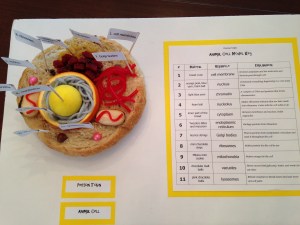Mr. Star Wars just completed a science cell project– at home. While he could have completed the entire project on his own, this is one of those projects that a parent is probably going to have to offer help in some way. In our case, I drove to the grocery store to buy supplies and helped with formatting his written explanations on the computer. How much help is too much? As a teacher, if I send a multi-day 3-D project home like this, I know parents will be involved. The key is to provide only enough support that you do not “compromise the integrity” of the student project.
Parent Dos
- Read through the project assignment sheet and directions with your child.
- Brainstorm a list of supplies and tentative “plan” for completing the project with your child (what to complete each day, so you finish by the deadline). This is a conversation that can happen at the dinner table or in the car on the way home from school.
- Source supplies (make a trip to the grocery store, Michael’s crafts, hardware store, your pantry/junk closet at home).
- Reread the directions with your student when the project is finished to make sure the student has completed all of the requirements.
Parent Don’ts
- Write anything.
- Rewrite anything.
- Build anything while a child stands to the side and watches.
Good Project Supplies
If you have class projects come home more than twice a year, I would recommend investing in some common project supplies and saving a few items that can be hard to get when you need it at the last minute. I love having these items on hand at the 11th hour!
- shoeboxes
- paper cutter
- cardstock– assorted colors (Astrobrights are great!)
- Avery labels– small and large size
- one set of Sharpie markers in bright colors




















